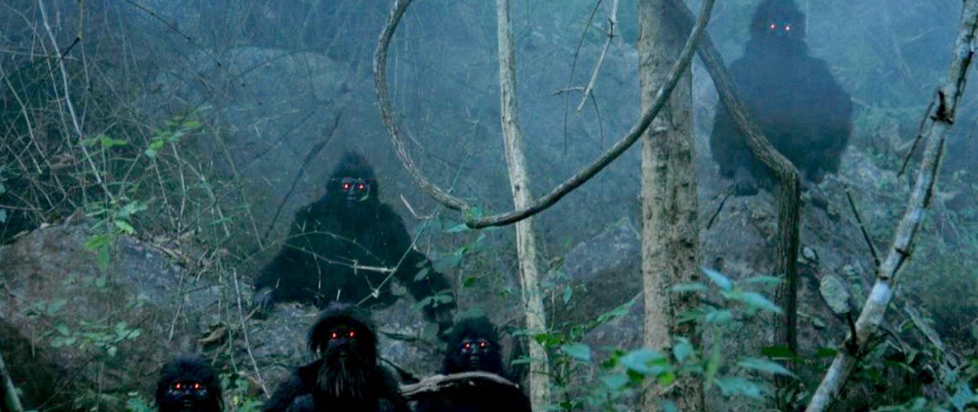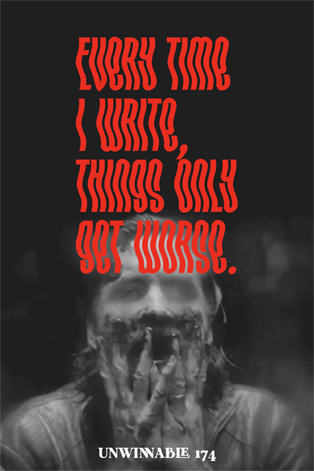
2011

This column is a reprint from Unwinnable Monthly #174. If you like what you see, grab the magazine for less than ten dollars, or subscribe and get all future magazines for half price.
———
Kcab ti nur.
———
Bring your snapbacks and your lucky amulets, this month we’re heading back to 2011, taking a look at two films which show us how the world beyond etches itself onto our reality.
In Uncle Boonmee Who Can Recall His Past Lives, a plantation owner is visited by his family as he dies from kidney failure and in this long slow dying the barriers our world and the spirits grows ever thinner. This is introduced through in my favorite scene of the film, where Boonmee and his visiting nephew Tong (Sakda Kaewbuadee) and sister-in-law Jen (Jenjira Pongpas) all have dinner together and suddenly the ghost of Boonmee’s long-deceased wife Huay (played by Natthakarn Aphaiwong) slowly fades into frame. Slowly but surely, she becomes more and more material-looking as the dinner goes, on and at a certain point she just becomes one of the cast for most of the rest of the film.
Boonmee takes an almost ambivalent approach to the death and the supernatural – refusing clean conclusions or banal questions about whether its events are real or imagined. This refusal of closure is not only a broad philosophy, but also specifically situated in violence of the past and present. The nexus of this complexity comes in the character for whom the film is named.
Thanapat Saisaymar gives a deeply charismatic and sensitive performance which endears you to the titular dying character. But Boonmee is deeply morally compromised. As the film plays out, we see that while not as outright xenophobic as his sister, he regularly employs migrant workers knowing he can exploit them to do the labor that he can’t on this large plantation. While referring to his closest Laotian helper Jaai with warm regard, he gets no invite to the family dinner table early in the film. Boonmee is also implied to have been directly involved in some of the many killings of pro-democracy/left-leaning people by right-wing militias – most notoriously demonstrated by the Red Drum Murders.

Midway through, he expresses a sentiment that is almost remorse. He says that the kidney failure is likely karma for his role in the killing of communists or for killing bugs around the farm. His sister replies that he did it for his country to try and reassure him, but there’s a sort of hollowness to the tone where they both don’t fully believe it. There’s no breakdown, or grand moment of full complete change, soon enough we’ve drifted away to the next scene.
After all, why should we the audience get an easy resolution when the victims of various massacres in the country have never seen justice – even in the limited sense that the judicial system sometimes affords? When the dead fall away unhonored and unnamed? When political dissidents like Surachai Danwattananusorn are still dying under suspicious circumstances?
The hauntings of Visitation are certainly less calm, but once again there’s also no sense of a hero. The outer world bears no moral absolution, just strange sounds and textures. Indistinguishable sufferings surround the dreaming observer. Charcoal bodies contort into barely recognizable charcoal shapes. Sounds fill your ears and it’s never clear whether they are the sounds of screams or machines grinding and squealing. Bob Bronow’s sound mix keeps you constantly unmoored, forcing you to be as overwhelmed as the dreamer with its layers.

Pitt’s film also conveys a point where the walls between realities blur, but her angle is much more Lovecraftian, following a dreamer who is whispered to from the outer worlds. This is a journey animated in charcoal. Where Pitt’s most notable work Asparagus is vibrant and beautiful in its strangeness, this monochrome method is no less adventurous. Through this methodology, we are given figures that blur into each other, beyond comprehension and radiate dread.
I think charcoal is a particularly interesting medium through which to show an afterlife. In the immediate it evokes William Blake’s dark satanic mills and the churning of industry that have their fingerprints all over this short film. But also charcoal itself must come from a living thing now severed and incinerated. Life after death but only to further produce and produce. It’s a depressing vision but again one that is materially situated in the context of a nation in which people exist as fuel for the hungering machines of war and capital. After all this is the year when the first US citizens are executed without trial via an American state-ordered drone strike. Countless souls linger with business unresolved as the cogs churn and smoke billows.
For both of these films, atmosphere is everything, conveying a different kind of dreaminess haunted by the blood of the past/present/future yet each being deeply informed by the ground on which the dreamer walks. Maybe the cries of the other world could tell us something about ourselves if we’d just listen.
———
Oluwatayo Adewole is a writer, critic and performer. You can find her Twitter ramblings @naijaprince21, his poetry @tayowrites on Instagram and their performances across London.




